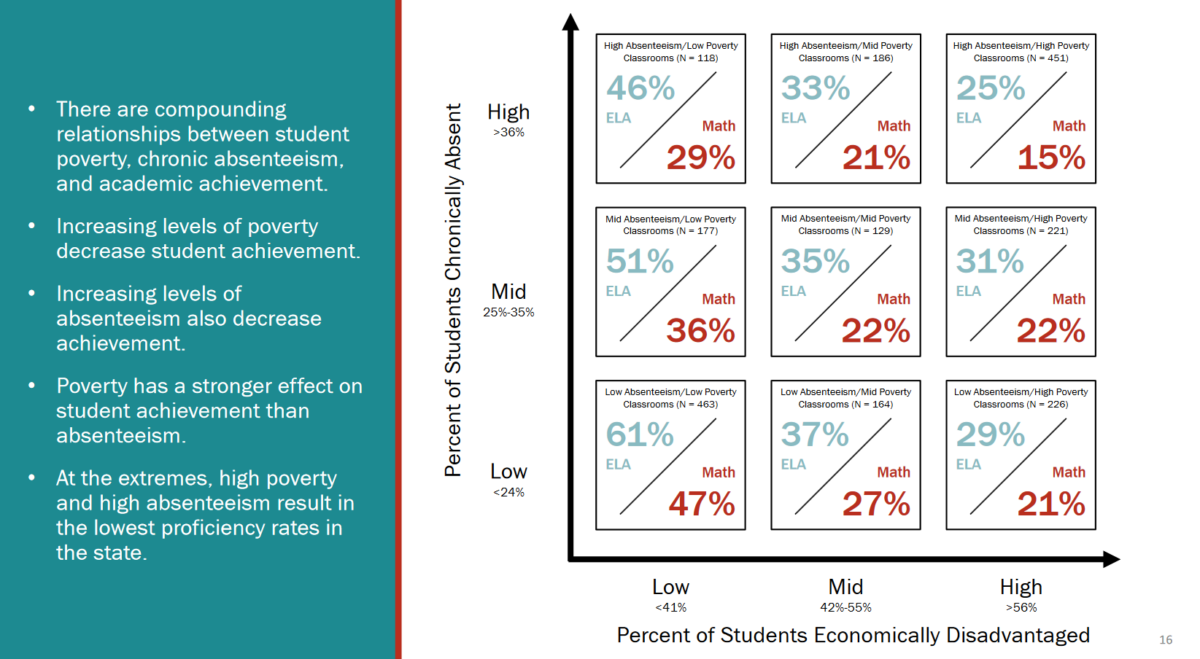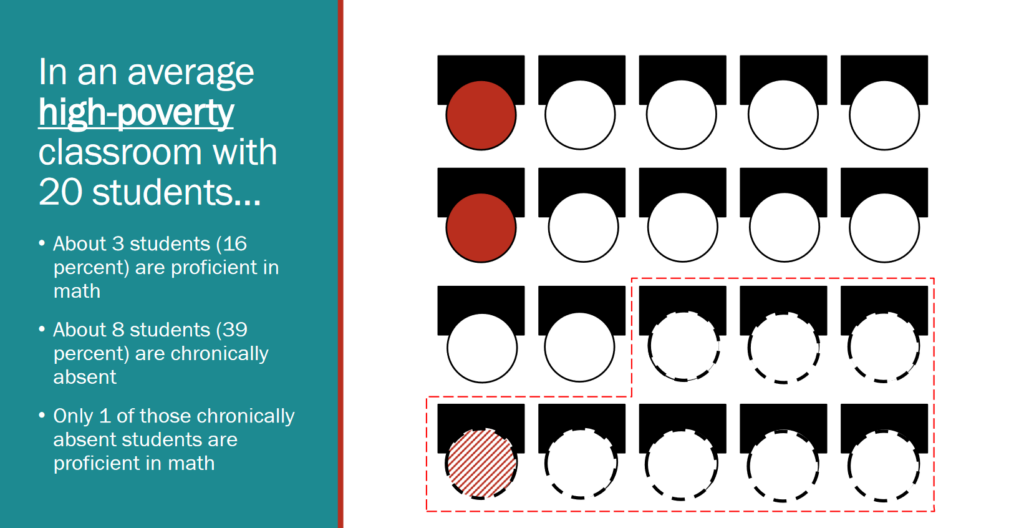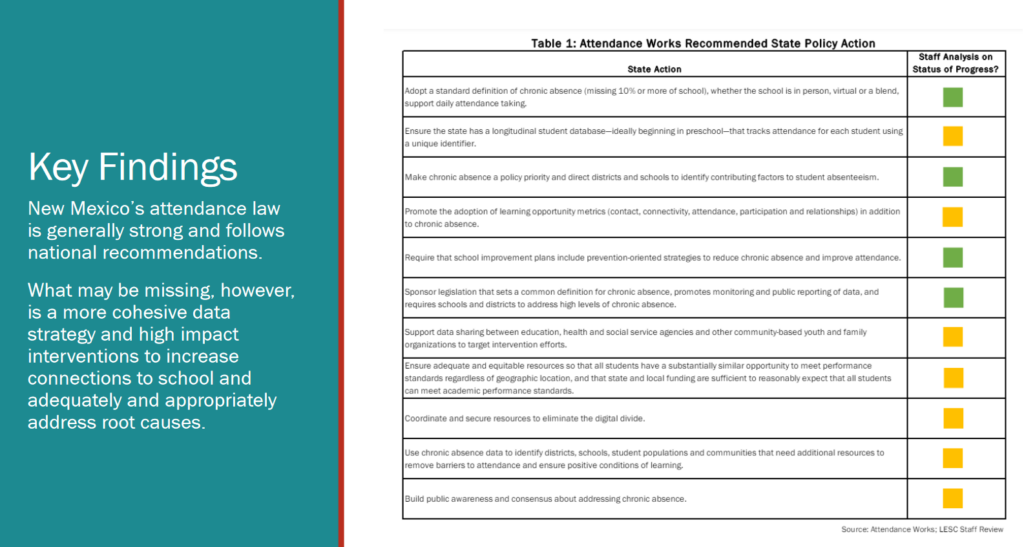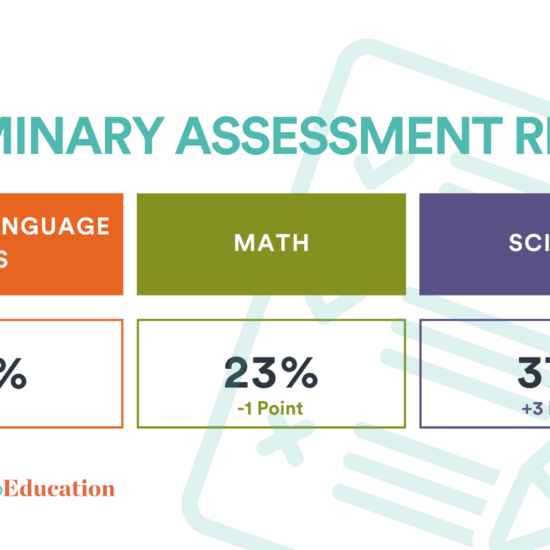
A Persistent Challenge in Public Education
New Mexico lawmakers are looking to tackle the state’s absentee rate among its public school students.
A new report from the Legislative Education Study Committee (LESC) and the Legislative Finance Committee (LFC) staff found almost 40 percent of New Mexico’s students were chronically absent in the 2022-2023 school year.
In late June, senior policy analysts Jessica Hathaway and Tim Bedeaux from the LESC joined Sarah Densus and John Valdez from the LFC to address this significant concern.
The presentation included an overview of the legislature’s ongoing efforts to address attendance issues, highlighting the impacts of the COVID-19 pandemic on student attendance and the broader educational landscape.
Hathaway emphasized the crucial role of attendance in ensuring the effectiveness of New Mexico’s public education system, saying that “strong student attendance helps our classrooms thrive and supports the broader societal and economic well-being.”
In 2019, the New Mexico legislature passed the Attendance for Success Act, a comprehensive bill aimed at supporting school attendance by gathering data on where and why students miss class. This Act defined chronic absenteeism as missing 10 percent or more of school days for any reason and established a tiered system to track attendance and align interventions accordingly.
However, the pandemic’s onset in the same year significantly disrupted the implementation of the new measures.
The stark reality of chronic absenteeism
LESC staff told lawmakers about particularly high chronic absenteeism rates among Native American students (48.3 percent), students with disabilities (44.2 percent), English language learners (43.1 percent), and economically disadvantaged students (42.5 percent). They noted in their report that these figures are above the state average, once again showing the persistent disparities highlighted in the Martinez-Yazzie lawsuit, in which the court found that the state was failing to provide a “sufficient” education to students in these demographic groups.
Bedeaux presented a classroom-level analysis, which showed lawmakers the compounded effects of poverty and chronic absenteeism on student proficiency in reading and math. The most recent information from the PED showed only 38 percent of students can read at grade level, while only 24 percent of students can do math at grade level.
The data is worse the further it breaks down, with poverty contributing significantly to failing student proficiency rates.
He explained that in the average New Mexico high-poverty classroom, only 23 percent of students are proficient in reading, and just 16 percent are proficient in math. This analysis starkly contrasted with classrooms in low-poverty districts, where proficiency rates were significantly higher.


Legislative Finance Committee findings
Densus and Valdez presented findings from the LFC’s recent program evaluation on school attendance and performance.
Their report revealed a 119 percent increase in chronic absenteeism in New Mexico from 2019 to 2023, the second-highest increase in the nation. They emphasized that chronic absenteeism in early grades affects both near-term reading and math proficiency and long-term high school graduation rates.
The LFC identified several key challenges, including inconsistent attendance-taking practices and inadequate implementation of tiered interventions. They recommended several strategies to address these issues, such as adjusting school calendars to accommodate cultural events, requiring extra school time for chronically absent students, and withholding credit for excessive absenteeism.
Moving forward
Hathaway concluded the presentation by outlining the LESC’s plans for further analysis and predictions on which schools and districts will have higher absenteeism in order to match interventions with specific attendance issues. She stressed the need for tailored, locally driven interventions that move beyond communication and planning to address the root causes of absenteeism.
The discussion underscored the complexity of addressing chronic absenteeism, with factors ranging from poverty and health issues to cultural obligations and student engagement.
The committee acknowledged the need for a multifaceted approach, combining legislative action with community engagement and support from various state agencies.
Six key recommendations from the report:
- Amend the Attendance for Success Act: Allow districts to require extra instructional time for some excessively absent students.
- Publish attendance rules: The Public Education Department (PED) should publish formal rules regarding attendance-taking practices.
- Best practice interventions: PED should provide a publicly accessible list of best practice interventions to improve absenteeism.
- Parental engagement: Schools and PED should increase efforts to inform parents about the impact of attendance on academic performance.
- Teacher incentives: Implement and evaluate teacher incentive programs to improve attendance.
- Adjust school calendars: Allow schools within districts to set separate calendars to meet specific cultural needs. The report found that many students miss school to attend cultural ceremonies.
The New Mexico legislature’s ongoing focus on chronic absenteeism highlights a critical issue within the state’s education system. Both LESC and LFC staff told lawmakers that with comprehensive analysis and strategic interventions, they can create a more supportive environment that ensures all students have the opportunity to thrive academically and personally.








